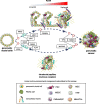The cross-talk between the macro and micro-environment in precursor lesions of pancreatic cancer leads to new and promising circulating biomarkers
- PMID: 39020414
- PMCID: PMC11256648
- DOI: 10.1186/s13046-024-03117-5
The cross-talk between the macro and micro-environment in precursor lesions of pancreatic cancer leads to new and promising circulating biomarkers
Abstract
Pancreatic cancer (PC) is a clinically challenging tumor to combat due to its advanced stage at diagnosis as well as its resistance to currently available therapies. The absence of early symptoms and known detectable biomarkers renders this disease incredibly difficult to detect/manage. Recent advances in the understanding of PC biology have highlighted the importance of cancer-immune cell interactions, not only in the tumor micro-environment but also in distant systemic sites, like the bone marrow, spleen and circulating immune cells, the so-called macro-environment. The response of the macro-environment is emerging as a determining factor in tumor development by contributing to the formation of an increasingly immunogenic micro-environment promoting tumor homeostasis and progression. We will summarize the key events associated with the feedback loop between the tumor immune micro-environment (TIME) and the tumor immune macroenvironment (TIMaE) in pancreatic precancerous lesions along with how it regulates disease development and progression. In addition, liquid biopsy biomarkers capable of diagnosing PC at an early stage of onset will also be discussed. A clearer understanding of the early crosstalk between micro-environment and macro-environment could contribute to identifying new molecular therapeutic targets and biomarkers, consequently improving early PC diagnosis and treatment.
Keywords: Circulating biomarkers; Immune landscape; Macro-environment; Micro-environment; Pancreatic cancer.
© 2024. The Author(s).
Conflict of interest statement
The authors declare that they have no known competing financial interests or personal relationships that could have appeared to influence the work reported in this paper.
Figures


References
Publication types
MeSH terms
Substances
LinkOut - more resources
Full Text Sources
Medical

